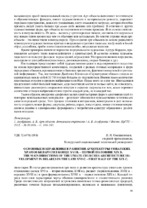| dc.contributor.author | Ожешковская, И. Н. | ru |
| dc.coverage.spatial | Минск | ru |
| dc.date.accessioned | 2021-10-13T07:59:10Z | |
| dc.date.available | 2021-10-13T07:59:10Z | |
| dc.date.issued | 2021 | |
| dc.identifier.citation | Ожешковская, И. Н. Основные направления в развитии архитектуры униатских храмов Беларуси в конце XVI в. – первой половине XIX в. = The main directions of the uniate churches architecture de-velopment in Belarus in the late XVI c. - first half of the XIX c. / И. Н. Ожешковская // Архитектура во времени и пространстве : материалы международной научно-практической конференции, 29 апреля 2021 г. / сост. М. И. Китаев ; редкол.: Е. Е. Нитиевская (отв. ред.) [и др.]. – Минск : БНТУ, 2021. – С. 59-64. | ru |
| dc.identifier.uri | https://rep.bntu.by/handle/data/104182 | |
| dc.description.abstract | В статье рассматриваются три этапа в развитии архитектуры униатских храмов: становление (конец XVI в. – вторая половина XVII в.), расцвет (первая половина XVIII в. – середина XVIII в.) и трансформация (конец XVIII в. – первая половина XIX в.). Каждый период имел свои характерные черты объемно-планировочного и стилистического решения. Среди стилистических направлений встречались памятники готико-ренессансных традиций, различные течения барокко (итальянизированное, виленское и несвижское (инситное)),барочного классицизма и классицизма. Многие храмы обладали уникальными художественно-стилистическими и планировочными приемами и явились существенным фактором развития многообразия форм храмостроения на территории Беларуси. | ru |
| dc.language.iso | ru | ru |
| dc.publisher | БНТУ | ru |
| dc.title | Основные направления в развитии архитектуры униатских храмов Беларуси в конце XVI в. – первой половине XIX в. | ru |
| dc.title.alternative | The main directions of the uniate churches architecture de-velopment in Belarus in the late XVI c. - first half of the XIX c. | ru |
| dc.type | Working Paper | ru |
| local.description.annotation | The article considers three stages in the development of the architecture of Uniate churches: formation (the end of the XVI c. - the second half of the XVII c.), flourishing (the first half of the XVIII c. - the middle of the XVIII c.) and transformation (the end of the XVIII c. - the first half of the XIX c.). Each period had its own characteristic features of spatial planning and stylistic solutions. Among the stylistic trends, there were monuments of Gothic-Renaissance traditions, various trends of the Baroque (Italianized, Vilna and Nesvizh (insite)), Baroque Classicism and Classicism styles. Many churches had unique artistic, stylistic and planning techniques and were an essential factor in the development of a variety of forms of church construction on the territory of Belarus. | ru |

